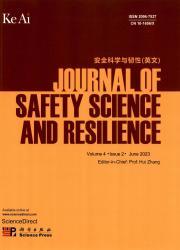Studying the dynamics of crowd panic propagation during emergency evacuation
IF 3.4
Q1 PUBLIC, ENVIRONMENTAL & OCCUPATIONAL HEALTH
引用次数: 0
Abstract
Casualties during emergency evacuations are often attributed to people’s panic-driven extreme behaviors rather than the accidents themselves. The propagation of panic is influenced by various factors. Based on the susceptible–infectious–recovered–susceptible (SIRS) model, a system dynamics (SD) model was developed using AnyLogic software to investigate the spread of panic emotions within a population. A case study focused on hospital emergency evacuations was conducted, wherein factors influencing panic propagation were divided into individual and group levels. The population was classified into three categories—staff, caregivers, and patients—and the effect of the ratio of these categories on evacuation efficiency was examined. Based on these classifications, an evacuation simulation experiment was conducted to examine the effects of panic emotions on evacuation efficiency. Results indicate that optimal hospital evacuation efficiency is achieved with a staff:caregiver:patient ratio of 2:2:1. The overall evacuation process is significantly impacted by panic, resulting in a 64 % increase in evacuation times when panic propagation is considered compared to scenarios where it is not. Furthermore, the initial 10 s following a disaster were identified as crucial for managing severe panic. Valuable insights for improving emergency evacuation management are provided by this study.
研究紧急疏散过程中人群恐慌传播的动态
紧急疏散中的人员伤亡往往是由于人们的恐慌导致的极端行为,而不是事故本身。恐慌的传播受到多种因素的影响。在易感-感染-恢复-易感(SIRS)模型的基础上,利用AnyLogic软件建立了系统动力学(SD)模型,以调查人群中恐慌情绪的传播。以医院紧急疏散为研究对象,将影响恐慌传播的因素分为个体和群体两个层面。将人群分为三类——工作人员、护理人员和患者——并检查这些类别的比例对疏散效率的影响。在此基础上,进行了疏散模拟实验,考察了恐慌情绪对疏散效率的影响。结果表明,工作人员:护理人员:患者的比例为2:2:1时,医院后送效率达到最佳。整个疏散过程受到恐慌的严重影响,与不考虑恐慌传播的情况相比,考虑恐慌传播的疏散时间增加了64%。此外,灾难发生后最初的10秒被认为是管理严重恐慌的关键。本研究为改进应急疏散管理提供了有价值的见解。
本文章由计算机程序翻译,如有差异,请以英文原文为准。
求助全文
约1分钟内获得全文
求助全文
来源期刊

安全科学与韧性(英文)
Management Science and Operations Research, Safety, Risk, Reliability and Quality, Safety Research
CiteScore
8.70
自引率
0.00%
发文量
0
审稿时长
72 days
 求助内容:
求助内容: 应助结果提醒方式:
应助结果提醒方式:


